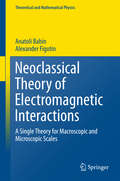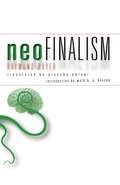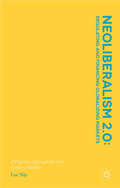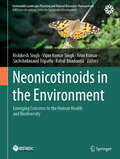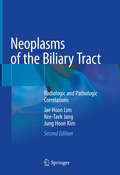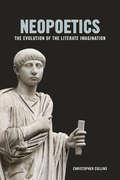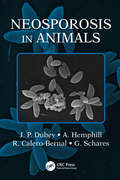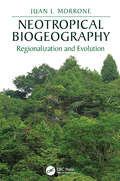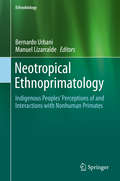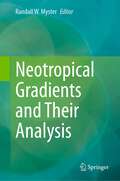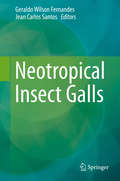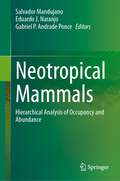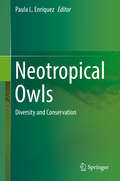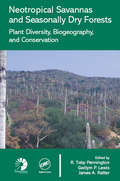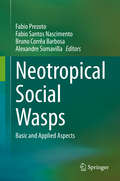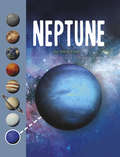- Table View
- List View
Neo-Thinking on Ganges-Brahmaputra Basin Geomorphology
by Balai Chandra Das Sandipan Ghosh Aznarul Islam Md IsmailThis book explores the latest advances in our understanding of the evolution of the Ganga-Brahmaputra delta, examining the Damodar basin, Bhagirathi-Hooghly basin and Jalangi basin from historical, quantitative and applied geomorphology perspectives. The evolution of the Ganga-Brahmaputra delta is highly complex and remains poorly understood. To address that gap, this edited volume presents 11 research papers: the first seven chapters focus on the pure geomorphology and geohydrology of the delta, while the remaining four examine its applied geomorphological aspects. The book offers a valuable guide for geologists, geographers, hydrologists, landscape ecologists, environmentalists, engineers, planners and policy makers.
Neo-Victorian Madness: Rediagnosing Nineteenth-Century Mental Illness in Literature and Other Media
by Brenda Ayres Sarah E. MaierNeo-Victorian Madness: Rediagnosing Nineteenth-Century Mental Illness in Literature and Other Media investigates contemporary fiction, cinema and television shows set in the Victorian period that depict mad murderers, lunatic doctors, social dis/ease and madhouses as if many Victorians were “mad.” Such portraits demand a “rediagnosing” of mental illness that was often reduced to only female hysteria or a general malaise in nineteenth-century renditions. This collection of essays explores questions of neo-Victorian representations of moral insanity, mental illness, disturbed psyches or non-normative imaginings as well as considers the important issues of legal righteousness, social responsibility or methods of restraint and corrupt incarcerations. The chapters investigate the self-conscious re-visions, legacies and lessons of nineteenth-century discourses of madness and/or those persons presumed mad rediagnosed by present-day (neo-Victorian) representations informed by post-nineteenth-century psychological insights.
Neoclassical Theory of Electromagnetic Interactions
by Anatoli Babin Alexander FigotinIn this monograph, the authors present their recently developed theory of electromagnetic interactions. This neoclassical approach extends the classical electromagnetic theory down to atomic scales and allows the explanation of various non-classical phenomena in the same framework. While the classical Maxwell-Lorentz electromagnetism theory succeeds in describing the physical reality at macroscopic scales, it struggles at atomic scales. Here, quantum mechanics traditionally takes over to describe non-classical phenomena such as the hydrogen spectrum and de Broglie waves. By means of modifying the classical theory, the approach presented here is able to consistently explain quantum-mechanical effects, and while similar to quantum mechanics in some respects, this neoclassical theory also differs markedly from it. In particular, the newly developed framework omits probabilistic interpretations of the wave function and features a new fundamental spatial scale which, at the size of the free electron, is much larger than the classical electron radius and is relevant to plasmonics and emission physics. This book will appeal to researchers interested in advanced aspects of electromagnetic theory. Treating the classical approach in detail, including non-relativistic aspects and the Lagrangian framework, and comparing the neoclassical theory with quantum mechanics and the de Broglie-Bohm theory, this work is completely self-contained.
Neofinalism (Posthumanities #36)
by Raymond RuyerAlthough little known today, Raymond Ruyer was a post–World War II French philosopher whose works and ideas were significant influences on major thinkers, including Deleuze, Guattari, and Simondon. With the publication of this translation of Neofinalism, considered by many to be Ruyer&’s magnum opus, English-language readers can see at last how this seminal mind allied philosophy with science.Unfazed by the idea of philosophy ending where science began, Ruyer elaborated a singular, nearly unclassifiable metaphysics and reactivated philosophy&’s capacity to reflect on its canonical questions: What exists? How are we to account for life? What is the status of subjectivity? And how is freedom possible? HaNeofinalism offers a systematic and lucidly argued treatise that deploys the innovative concepts of self-survey, form, and absolute surface to shape a theory of the virtual and the transspatial. It also makes a compelling plea for a renewed appreciation of the creative activity that organizes spatiotemporal structures and makes possible the emergence of real beings in a dynamic universe.
Neogene Micropaleontology and Stratigraphy of Argentina
by Hugo MarengoThis book gathers and updates the most significant advances of the last two centuries and presents an unprecedented micro paleontological study covering more than 20 stratigraphic sections. This information is supplemented by numerous sedimentological observations and analyses, on the basis of which a new lithostratigraphic framework for the Neogene of the Chacoparanense Basin is proposed. The book is structured in an easy-to-read format: Its main section offers a comprehensive review of the current state of knowledge on transgressions in Argentina and similar transgressions in other South American countries, taking into account various key aspects (age, paleoenvironment, micropaleontology, etc. ). Secondly, the book presents the main results on the TLP and TEP of the Chacoparanense Basin and the TEP of the Península de Valdés. Lastly, it provides readers with complete stratigraphic profiles (Appendix A), mineralogical analyses (Appendix B), distribution charts (Appendix C), systematics (Appendix D) and plates (Appendix E).
Neoliberalism 2.0: A Pigovian Approach for 21st Century Markets
by L. NijsIn today's increasingly globalized environment, many economic fundamentals need to be reconsidered in order to regain stability in the global marketplace. One such consideration is the failing dynamics of the international tax infrastructure. Neoliberalism 2.0 brings a 21st century assessment of the Pigovian taxes, considering a completely new calibration of the international tax systems, inspired by the historically developed Pigovian tax model. The book considers the impact neoliberalism had and will have on regulatory infrastructure, democracy in an era of globalization and reduced legitimation of the national state. The Pigovian model brings home the often forgotten relationship between taxation (as a part of the regulatory sphere), macro-economics, and the political-philosophical context in which law and economics emerge. The model also takes into account the phenomena of globalization and financialization and is tested using the financial sector as an example. This book addresses the many challenges a Pigovian shift would imply for the sovereign and its national economies. Neoliberalism 2.0 demonstrates the ability to design a paradigm-changing alternative to the current tax infrastructure, while taking into account a low economic growth environment of the future, the implications of globalization and the changing relationship between citizens and their state.
Neoliberalism and Technoscience: Critical Assessments (Theory, Technology And Society Ser.)
by Marja YlönenThis book provides a comprehensive assessment of the connection between processes of neoliberalization and the advancement and transformation of technoscience. Drawing on a range of theoretical insights, it explores a variety of issues including the digital revolution and the rise of immaterial culture, the rationale of psychiatric reforms and biotechnology regulation, discourses of social threats and human enhancement, and carbon markets and green energy policies. A rich exploration of the overall logic of technoscientific innovation within late capitalism, and the emergence of a novel view of human agency with regard to the social and natural world, this volume reveals the interdependence of technoscience and the neoliberalization of society. Presenting the latest research from a leading team of scholars, Neoliberalism and Technoscience will be of interest to scholars of sociology, politics, geography and science and technology studies.
Neonicotinoids in the Environment: Emerging Concerns to the Human Health and Biodiversity (Sustainable Landscape Planning and Natural Resources Management)
by Arun Kumar Rishikesh Singh Rahul Bhadouria Vipin Kumar Singh Sachchidanand TripathiThe proposed book presents the current state of knowledge about the processes, parameters, and phenomena that influence the fate of neonicotinoids in soil-water systems (i.e., soil and groundwater), as well as their effects and mitigation measures, and identifies existing knowledge gaps. Furthermore, groundwater/surface water interactions, as well as sorption, biodegradation, and chemical transformations of neonicotinoids in the soil and leaching to the groundwater, are highlighted, as they determine their further migration from sources, through soils to groundwater systems, and then to other environmental compartments, posing ecological and human risks. The ecological risks of neonicotinoids are highlighted in a separate section with special emphasis on the impacts on biological diversity.
Neoplasms of the Biliary Tract: Radiologic and Pathologic Correlations
by Jung Hoon Kim Jae Hoon Lim Kee-Taek JangThis book provides a thorough overview of the radiologic and pathologic findings of neoplastic diseases of the biliary tract, a sound knowledge of which is essential for appropriate patient management. A key feature is the correlation of imaging findings with both gross pathologic and histopathologic findings for each disease. This is of the utmost importance in understanding true pathologic abnormalities, bearing in mind, for example, the difficulty in ascertaining disease spread and extent on the basis of pathology alone. Since the first edition of the book, conceptual understanding of neoplastic disease of the bile ducts and cholangiocarcinogenesis has evolved significantly, and in the new edition the classification of diseases is based on the most recent edition of the WHO Classification of Tumors of the Digestive System. In addition, some newly recognized pathologies are covered. The book will enhance understanding of the pathology of neoplastic diseases of the biliary tract and aid imaging interpretation. It will be a great asset for pathologists, radiologists, biliary surgeons, and gastroenterologists.
Neopoetics: The Evolution of the Literate Imagination
by Christopher CollinsThe quest to understand the evolution of the literary mind has become a fertile field of inquiry and speculation for scholars across literary studies and cognitive science. In Paleopoetics, Christopher Collins's acclaimed earlier title, he described how language emerged both as a communicative tool and as a means of fashioning other communicative tools—stories, songs, and rituals. In Neopoetics, Collins turns his attention to the cognitive evolution of the writing-ready brain. Further integrating neuroscience into the popular field of cognitive poetics, he adds empirical depth to our study of literary texts and verbal imagination and offers a whole new way to look at reading, writing, and creative expression. Collins begins Neopoetics with the early use of visual signs, first as reminders of narrative episodes and then as conventional symbols representing actual speech sounds. Next he examines the implications of written texts for the play of the auditory and visual imagination. To exemplify this long transition from oral to literate artistry, Collins examines a wide array of classical texts—from Homer and Hesiod to Plato and Aristotle and from the lyric innovations of Augustan Rome to the inner dialogues of St. Augustine. In this work of "big history," Collins demonstrates how biological and cultural evolution collaborated to shape both literature and the brain we use to read it.
Neosporosis in Animals
by R. Calero-Bernal J.P. Dubey A. Hemphill Gereon ScharesKey features: Written by the scientist who named this parasite and was the first to set up proper diagnostic techniques Serves as the first ever book to provide information on the parasite structure, biology, pathogenesis, clinical signs, epidemiology, prevention, and control of neosporosis Covers both approaches toward preventing & controlling this disease: Developing an efficacious vaccine and sound cattle management practices Contains a wealth of illustrations, including many of the author's original photographs of the parasite Provides basic information on immunologic and molecular aspects of the disease Abortion is a worldwide problem in the livestock industry accounting for annual economic losses of billions of dollars, and N. caninum is a major cause of it. Neosporosis is a newly recognized disease of animals. Until 1988 it was misdiagnosed as toxoplasmosis. Considerable progress in understanding the biology of neosporosis has been made in the last 30 years, resulting in more than 2,000 scientific publications. The economic importance of abortion in cattle, and the availability of knowledge, reagents, and technology used to study toxoplasmosis, have contributed to the rapid progress in understanding the biology of neosporosis. Written by pioneers in this field, Neosporosis in Animals presents a comprehensive summary of the biology of neosporosis, starting with chapter 1 on the historical background of the discovery of the disease. Subsequent chapters deal with general aspects of the biology of N. caninum (chapter 2), techniques (chapter 3), and the disease caused by this parasite in cattle (chapter 4), dogs (chapter 5), and all other animals including sheep, pigs, primates and humans (chapters 6-18). This book provides, for the first time in a single authoritative source, a complete account of the structure, biology, clinical disease, diagnosis, epidemiology, treatment, attempts at immunoprophylaxis, and control in all hosts. There are 175 illustrations and tables devoted to the life cycle, structure of parasitic stages, and lesions. More than 2100 references are cited, allowing the reader to locate additional information on specific topics in an efficient way. This book will be useful to a broad range of researchers in biology and veterinarians.
Neotropical Biogeography: Regionalization and Evolution (CRC Biogeography Series)
by Juan J. MorroneNeotropical Biogeography: Regionalization and Evolution presents the most comprehensive single-source treatment of the Neotropical region derived from evolutionary biogeographic studies. The book provides a biogeographic regionalization based on distributional patterns of plant and animal taxa, discusses biotic relationships drawn from track and cladistic biogeographic analyses, and identifies cenocrons (subsets of taxa within biotas identified by their common origin and evolutionary history). It includes maps, area cladograms and vegetation profiles. <P><P> The aim of this reference is to provide a biogeographic regionalization that can be used by graduate students, researchers and other professionals concerned with understanding and describing distributional patterns of plants and animals in the Neotropical region. It covers the 53 biogeographic provinces of the Neotropical region that are classified into the Antillean, Brazilian and Chacoan subregions, and the Mexican and South American transition zones.
Neotropical Birds of Prey: Biology and Ecology of a Forest Raptor Community
by David F Whitacre J. Peter JennyUntil recently, surprisingly little has been known about the biology and behavior of tropical forest raptors, including such basic aspects as diets, breeding biology, habitat requirements, and population ecology, information critical to the development of conservation efforts. The Peregrine Fund conducted a significant eight-year-long research program on the raptor species, including owls, in Tikal National Park in Guatemala to learn more about Neotropical birds of prey. Impressive and unprecedented in scale, this pioneering research also involved the development of new methods for detecting, enumerating, and studying these magnificent but often elusive birds in their forest home. Beautifully illustrated with photographs of previously little-known species, the resulting book is the most important single source for information on the lowland tropical forest raptor species found in Central America.Neotropical Birds of Prey covers twenty specific species in depth, including the Ornate Hawk-Eagle, the Barred Forest-Falcon, the Bat Falcon, and the Mexican Wood Owl, offering thorough synopses of all current knowledge regarding breeding biology and behavior, diet, habitat use, and spatial needs. Contributors to this landmark work also show how the populations fit together as a community with overlapping habitat and prey needs that can put them in competition with reptiles and mammalian carnivores as well, yet differ from one another in their nesting or feeding behaviors and population dynamics. The work's substantive original data offer interesting comparisons between tropical and temperate zone species, and provide a basis for establishing conservation measures based on firsthand research. Making available for the first time new data on the biology, ecology, behavior, and conservation of the majestic owls and raptors of the New World tropics, this book will appeal to a wide ornithological readership, especially the many raptor enthusiasts around the world.
Neotropical Diversification: Patterns and Processes (Fascinating Life Sciences)
by Valentí Rull Ana Carolina CarnavalThis book provides a comprehensive overview of the patterns of biodiversity in various neotropical ecosystems, as well as a discussion on their historical biogeographies and underlying diversification processes. All chapters were written by prominent researchers in the fields of tropical biology, molecular ecology, climatology, paleoecology, and geography, producing an outstanding collection of essays, synthetic analyses, and novel investigations that describe and improve our understanding of the biodiversity of this unique region. With chapters on the Amazon and Caribbean forests, the Atlantic rainforests, the Andes, the Cerrado savannahs, the Caatinga drylands, the Chaco, and Mesoamerica – along with broad taxonomic coverage – this book summarizes a wide range of hypotheses, views, and methods concerning the processes and mechanisms of neotropical diversification. The range of perspectives presented makes the book a truly comprehensive, state-of-the-art publication on the topic, which will fascinate both scientists and general readers alike.
Neotropical Endophytic Fungi: Diversity, Ecology, and Biotechnological Applications
by Luiz Henrique RosaThis pioneering book focuses on Neotropical endophytic fungi, providing a comprehensive overview of their diversity, ecology, and biotechnological applications in medicine, agriculture, and industry. Despite their rich diversity, the endophytic fungi associated with plants of Central and South American biomes remain largely unknown. The book addresses that knowledge gap by offering insights into Neotropic endophytic fungal community.
Neotropical Ethnoprimatology: Indigenous Peoples’ Perceptions of and Interactions with Nonhuman Primates (Ethnobiology)
by Bernardo Urbani Manuel LizarraldeEthnoprimatology is situated at the intersection between the biological and cultural subfields of anthropology. Research on the interface between human and nonhuman primates has been steadily increasing since 1997, when the term ethnoprimatology was first coined. Although there have been studies on human–nonhuman primate interactions in the tropical Americas, no single comprehensive volume has been published that integrates this information to fully understand it in this region. Eighteen novel chapters written by outstanding scholars with various backgrounds are included in this edited volume. They refer to the complex interconnections between different indigenous peoples with New World monkeys that sympatrically share their ancestral territories. Geographically, the range covers all of the Neotropics, from southern Mexico through northern Argentina. This work includes topics such as primates as prey and food, ethnozoology/ethnoecology, cosmology, narratives about monkeys, uses of primates, monkeys as pets, and ethnoclassification. Multiple views as well as diverse theoretical and methodological approaches are found within the pages. In sum, this is a compendium of ethnoprimatological research that will be prized by anthropologists, ethnobiologists, primatologists, conservationists, and zoologists alike.“This book… provides a historical benchmark for all subsequent research in ethnoprimatology in the Neotropics and beyond.” — Leslie E. Sponsel, University of Hawai´i at Mānoa.
Neotropical Gradients and Their Analysis
by Randall W. MysterThe importance of the Neotropics to the world's climate, biogeochemical cycling and biodiversity cannot be questioned. This book suggests that gradients are key to understanding both these issues and Neotropical ecosystem structure, function and dynamics in general. Those gradients are either spatial, temporal or spatio-temporal, where many temporal and spatio-temporal gradients are initiated by disturbances (e.g., tree-fall, landslide, cultivation). And in particular for the Neotropics, three large spatial gradients - latitude, longitude, altitude (elevation) - are of critical importance. The editor has over 30 years of experience investigating Neotropical gradients in Costa Rica, Puerto Rico, Peru and Ecuador, and has published 5 previous books on different aspects of the Neotropics. Once again he has assembled top-shelf Neotropical scientists and researchers, here to focus on gradients: their nature, interactions and how they structure ecosystems.
Neotropical Hard Ticks (Acari (Acari (Acari (Acari: Ixodida: Ixodidae): A Critical Analysis of Their Taxonomy, Distribution, and Host Relationships
by Alberto A. Guglielmone Richard G. Robbins Santiago NavaOf the 758 species of hard ticks (family Ixodidae) currently known to science, 137 (18%) are found in the Neotropical Zoogeographic Region, an area that extends from the eastern and western flanks of the Mexican Plateau southward to southern Argentina and Chile and that also includes the Greater and Lesser Antilles and the Galápagos Islands. This vast and biotically rich region has long attracted natural scientists, with the result that the literature on Neotropical ticks, which are second only to mosquitoes as vectors of human disease and are of paramount veterinary importance, is enormous, diffuse, and often inaccessible to non-specialists. In this book, three leading authorities on the Ixodidae have combined their talents to produce a summary of essential information for every Neotropical tick species. Under each species name, readers will find an account of the original taxonomic description and subsequent redescriptions, followed by an overview of its geographic distribution and host relationships, including a discussion of human parasitism. Additional sections provide detailed analyses of tick distribution by country and zoogeographic subregion (the Caribbean, southern Mexico and Central America, South America, and the Galápagos Islands), together with a review of the phenomenon of invasive tick species and examination of the many valid and invalid names that have appeared in the Neotropical tick literature. The text concludes with an unprecedented tabulation of all known hosts of Neotropical Ixodidae, including the tick life history stages collected from each host. This book is an invaluable reference for biologists and biomedical personnel seeking to familiarize themselves with the Neotropical tick fauna.
Neotropical Insect Galls
by Geraldo Wilson Fernandes Jean Carlos SantosThe book brings to light the most recent findings on the biogeography, biodiversity, host plant induction and natural history of gall inducing insects in the Neotropical region We attempt to summarize the work done so far in the region, promote several syntheses on many aspects such as host induction, host specialization, distribution among the several vegetation types and zones, the origin of super hosts and the mechanisms leading to geographical patterns in their distribution Furthermore, the book constructs new perspectives for deeper understanding of galling insect evolutionary ecology and biogeopgraphy in the region.
Neotropical Mammals: Hierarchical Analysis of Occupancy and Abundance
by Salvador Mandujano Eduardo J. Naranjo Gabriel P. Andrade PonceThis book reviews and synthesizes studies on local and regional occupancy and abundance of Neotropical mammals from central Mexico to South America. The book focuses primarily on addressing issues of a wide array of mammalian species from a population level in different habitats and ecosystems across the Neotropical region. Occupancy and abundance analyzed through hierarchical approaches with a variety of statistical tools are the central ecological parameters treated in the chapters of this volume. This book will be an updated reference for researchers, professionals, students, wildlife managers, and people interested in mammal ecology and conservation in tropical and subtropical regions.
Neotropical Owls
by Paula L. EnriquezThis book presents a comprehensive biological and ecological information about owls in the neotropic area. In addition the book covers topics such as threats and conservation strategies for these nocturnal birds of prey from 18 Neotropical countries. Owls are a good example of diversification processes and have developed evolutionary characteristics themselves. These species are found almost everywhere in the world but most of them are distributed in tropical areas and about a third of them live in the Neotropics. This biogeographic region has a high biodiversity and even share lineages of species from other continents because at some point all were part of Pangea. Although we still have much to know and understand about this diverse, scarcely studied and threatened group this work aims to be a precedent for future and further research on the subject.
Neotropical Savannas and Seasonally Dry Forests: Plant Diversity, Biogeography, and Conservation
by R. Toby Pennington James A. RatterMore often than not, when people think of a neotropical forest, what comes to mind is a rain forest, rather than a dry forest. Just as typically, when they imagine a savanna, they visualize the African plains, rather than those dry woodlands and grasslands found in the Neotropics. These same preconceptions can be found among scientists, as these ne
Neotropical Social Wasps: Basic and applied aspects
by Fabio Prezoto Fabio Santos Nascimento Bruno Corrêa Barbosa Alexandre SomavillaThis book provides updated information on this intriguing and exciting group of insects: Neotropical Social Wasps. These insects have a particular biology and their colonies are formed by a few cooperative females living in either small or massive, structured nests where stinging individuals organize their activities and defend their offspring. Topics include evolutionary aspects, biogeography, post-embryonic development, community behavior and ecology, economic importance, and research methods.
Neptune
by Melanie ChrismerBriefly describes the discovery of Neptune and its physical characteristics.
Neptune (Planets in Our Solar System)
by Steve FoxeFar off Neptune holds many mysteries! Its great distance from the sun makes it the coldest planet in the solar system. Discover the secrets of this chilly, blue ice giant that was named after the sea.


